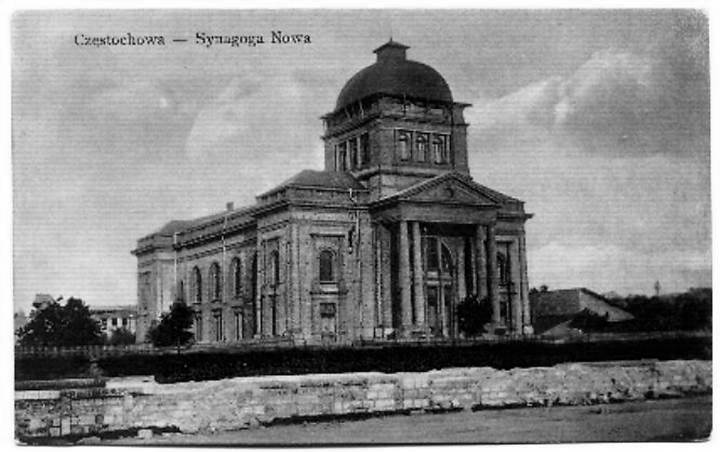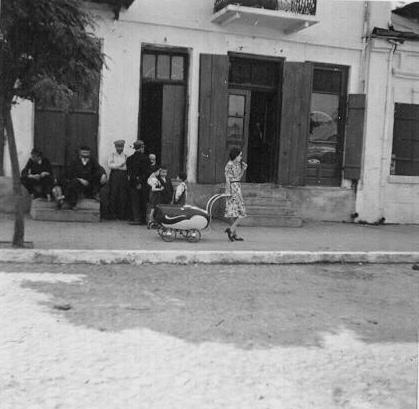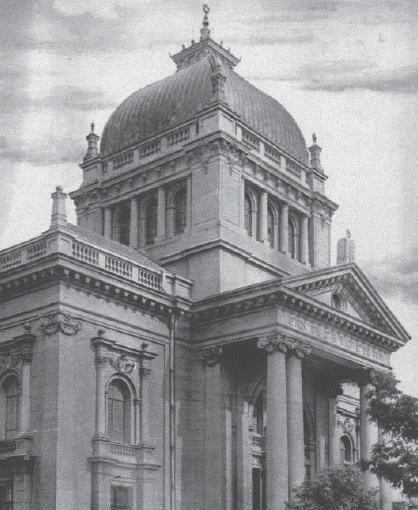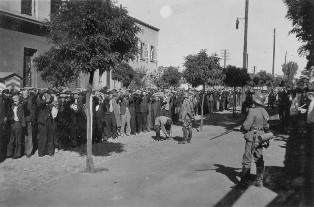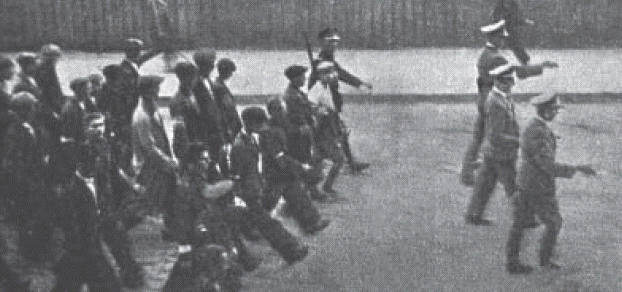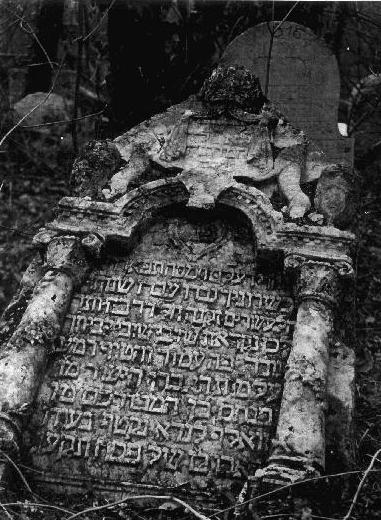Holocaust Education & Archive Research Team |
|
Ghettos
Introduction to the Ghettos of the Holocaust
Jewish Ghettos The Judenrat Judenrat Leaders Prominent Jews
| |||||
Czestochowa
Czestochowa was occupied on 3 September 1939. On the next day the Nazis killed 300 Jews, in an action known as "Bloody Monday". At that time approximately 28-30,000 Jews lived in the town (total population: 130-140,000).
Until 9 April 1941, when the ghetto was established, the Jews suffered from expropriation, humiliation and maltreatment. By June 1942 the ghetto’s population had increased to around 40-50,000; around 15,000 Jews from the surrounding area had been forced to move into the ghetto.
On 4 October 1942 all members of the Judenrat were deported to Treblinka (except Kopinski and Kurland), together with members of the Jewish ghetto police and their families. Kopinski was shot after the deportation, Kurland became chief of the Judenrat until 22 July 1943 when he was accused by the Germans of being disloyal. Finally he was shot at the Jewish cemetery.
Anisfelt was responsible for the organisation of the Jewish ghetto police. Its commander was a man named "Parasol", a former Polish army officer. The ghetto police numbered 250 persons. In August 1940 about 1,000 young men from Czestochowa between the ages of 18 and 25 were sent to the Forced Labour Camp Cieszanow -in the Lublin District. They were sent to build a highway; almost none survived. One of the survivors was Joseph Sher.
Forced labour camps were installed, for example in the armament factories and workshops of HASAG (Hugo Schneider Metallwarenfabrik AG, located in Leipzig): HASAG-Rakow (former ironworks in Rakow suburb, which was converted into an ammunition factory), HASAG-Pelcery (former textile factory near the station, also converted into an ammunition factory), Metalurgia (foundry on Krotka Street) and some more smaller factories or workshops.
Nobody in the ghetto believed that deportations would occur. Everybody assumed that the ghetto was important for war production. Even when in July / August 1942 many Warsaw Jews escaped to Czestochowa and talked about deportations to the Treblinka death camp, the Jews of Czestochowa did not believe them. Horrible stories, told by Treblinka escapees, were called "the imagination of sick brains".
The ghetto clearing took place between 22 September 1942 and 8 October 1942. On Garibaldi Street some houses were prepared as storage rooms in which the plundered property was stored after the deportation. All entrances to the cellars were painted white so that the Germans could quickly find hidden Jews. The first “Aktion” was organized on Yom Kippur, 21 - 22 September 1942. In the night SS and Ukrainians from Trawniki surrounded the ghetto and installed lamps on the streets. Then the Jews were thrown out of their flats. They had to gather in front of the Metallurgia factory, where a selection took place. Around 7,000 Jews were forced to march to the railway ramp at Zawodzie. There they had to enter cattle wagons and were deported to Treblinka. 200 other people were killed on the spot, 350 selected for work. A mass grave for the murdered Jews was dug on Kawia Street.
Through loudspeakers they told the remaining Jews that all deportees lived in good conditions in the camps and that each volunteer would get 1 kg bread, jam and a plate of soup. Therefore many people went to the deportation square voluntarily. During the liquidation of the Big Ghetto approximately 40,000 Jews from Czestochowa were deported to Treblinka. Every death train consisted of 60 cattle wagons, each occupied by around 130 persons. About 2,000 people were murdered in the ghetto, including tenants of old people's homes and children from orphanages.
After the deportations only 5,000 Jewish forced labourers remained in the Small Ghetto, most of them strong or well educated. The Small Ghetto was located in the Northeast corner of the former Big Ghetto, at Nadrzeczna, Kozia, Mostowa, Spadek and Garncarska streets. It was the poorest and oldest part of the town. The ghetto was surrounded by barbed wire and had only one gate on Garncarska Street.
In the official German documents this ghetto was called "Zwangsarbeitslager Tschenstochau". Some Jews had to sort out plundered property in a big storehouse on Garibaldi Street. Others worked in the town's factories and several workshops. All Jews in the Small Ghetto had to wear numbers on their clothes.
On 25 June 1943 selected people were sent to work camps near the HASAG factories. At the beginning of July 1943 the Small Ghetto was liquidated. The last selection took place on 20-22 July 1943 when the last Jewish policemen and the last chairman of the Judenrat, Bernard Kurland, were selected together with people unable to work. They were executed at the Jewish cemetery.
HASAG-Pelcery was the biggest forced labour camp in Czestochowa. By the end of June 1944 around 5,000 Jews from Czestochowa and Lodz were forced to work there. In August 1944 another group of Jewish prisoners arrived at HASAG. They came from other work camps of the HASAG Company in the Radom district: Skarzysko-Kamienna, Radom, Kielce and from the Luftwaffe work camp in Deblin (Lublin district).
All these people were evacuated to Czestochowa because of the Soviet offensive in the summer of 1944. By the end of 1944 it was one of the biggest work camps in the Generalgouvernement with around 10,000 Jewish prisoners. The Jews lived in overcrowded barracks. Many died of starvation, the cruel treatment or from typhus. In December 1944 HASAG-Pelcery came under SS control and the conditions became worse, similar to those in a German concentration camp. There had been a Jewish resistance group organised since the summer of 1942. First attempts at armed resistance were made during the liquidation of the Big Ghetto. The main headquarters of the ZOB was on Nadrzeczna Street 66, hence this group was called "Fighting Group 66". In June 1943 the leader of the group, Dr Adam Wolberg, was denounced to the Gestapo and killed.
Between 23 and 26 June 1943 the SS surrounded the Small Ghetto. The resistance fighters did not know the exact date of this Aktion and were surrounded by a much greater number of police and SS. Those who were captured, were immediately deported to Treblinka. Finally the Germans destroyed the ghetto.
The man responsible for the deportations was SS-Hauptsturmführer Paul Degenhardt from Czestochowa Gestapo. He even killed personally and was described as perfect organiser. After the war he was sentenced to life imprisonment by a court in Lüneburg (Germany) because of the shooting of about 51 Jews.
Degenhardt replaced Hauptmann Heutz in spring 1942 as chief of the Czestochowa police. Between spring and summer 1942 the police command (later called Schupo-Kommando) was extended from 30 - 40 to 50 - 60 Germans. The headquarters were located at the Polish townhouse in 75 Marienallee Street.
Degenhardt was also chief of around 240 Polish policemen and the Jewish order service (ghetto police). He was subordinate to the Orpo (order police) commander Radom and SS- und Polizeiführer in Radom, SS-Standartenführer Dr. Böttcher who was sentenced to death in 1949.
In the summer of 1942 Böttcher, Blum, Feucht and Degenhardt met in Czestochowa. Degenhardt produced a ghetto map and explained the important facts about the ghetto Jews. Böttcher appointed him leader of the "resettlement" actions, commanding all activities. Later Degenhardt called himself the "father of the Jews". The Jews themselves regarded him as "the master of life and death".
Anna Bieszk's, Paulina Cisowska's, Marysia Krefta's and Dorota Lygas' website Getto Czestochowa. Dr Dick de Mildt, www.jur.uva.nl/junsv Special thanks to Jarek Bykowski from Czestochowa. Holocaust Historical Society
Copyright Robert Kuwalek and Carmelo Lisciotto H.E.A.R.T 2007
|
